Items
Date is exactly
2021-09-16
-
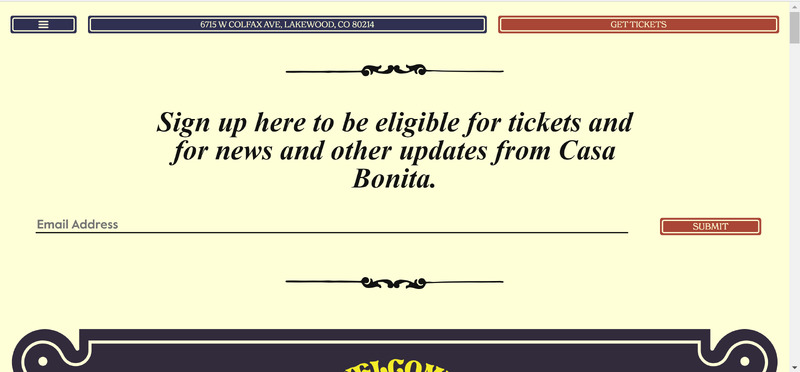 2021-09-16
2021-09-16Hotel California & Casa Bonita
My spouse and I love road trips and concerts. Covid definitely slowed us down! In the summer of 2021, we decided to take a road trip culminating in a concert in Denver, Colorado. Which concert? The Eagles - Hotel California! We drove and camped through Idaho, Wyoming, Utah, and Colorado. In Denver, we toured the famous restaurant Casa Bonita and went to the concert. For the concert, everyone needed a vaccination card and masks were required (although not widely worn). It was fun and felt a little like back-to-normal. We had a great time! -
 2021-09-16
2021-09-16Escaping Melbourne - HIST30060
This is a picture of Melbourne Airport (Tullamarine)’s Terminal 4. I flew out of Melbourne to get home to Tasmania just days before rising cases of the Delta variant forced state governments to shut borders once again. I remember the surreal feeling of passing through the airport then. Without the rush of people, the place felt gigantic. My eyes, typically drawn towards the way I needed to go, were able to refocus towards the ceilings, pillars and billboards. It felt like standing in a cathedral. As I was dwarfed by the sheer size of the terminal, I reflected on how COVID was reshaping billions of lives and world history as a whole too. -
 2021-09-16
2021-09-16Life is Better Where It's Wetter
Travel had always been in my blood. I can even remember the first time I was legally allowed to board a plane on my own without having to wear a silly "Unaccompanied Minor" badge around my neck. The idea of getting on an airplane and landing in a completely new place only hours later would always thrill me. Unfortunately, when the pandemic hit, travel started to look a little different. The freedom I once felt when I stepped foot on a 737 began to feel more like an anxiety-filled hassle. Normally, I would have been found jet-setting across the U.S. to the big cities on the east and west coasts where the parties lasted all night long, but that was no longer possible. I started to remembered how I had always wanted to visit Lake Tahoe. I'd always seen the outdoorsy girls on my Instagram feed post pictures of the clear, blue water. Maybe this was my chance to take a break from the major hubs and slow down my pace. One thing remained, though. I still didn't want to face those airports. That's when I made one of the biggest decisions of my young life. I packed up my Jeep and started out on what would become 3 weeks across our American highways - just me, a Jeep Wrangler, and the open road. I never could have expected what I would discover while driving. I truly gained a new appreciation for the world around me and realized I much preferred travel by wheel than by wing. Here I thought the freedom I felt when traveling was at risk of becoming obsolete, when in reality it was the opposite. Any time there was a unique store along the road or a picturesque landscape, I simply stopped. I never could have done that in an airplane! When I finally made it to the beach at California's gorgeous Lake Tahoe, I was speechless. It was everything I could have imagined and more. The views, the smells, the sounds - breathtaking. It was in those moments, I got my freedom back in the middle of a pandemic. -
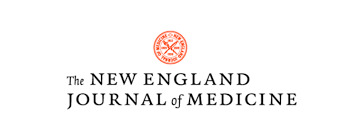 2021-09-16
2021-09-16The Importance of Context in Covid-19 Vaccine Safety
Vaccine safety is critical for the successful implementation of any vaccination program, especially during a pandemic. In February 1976, the Centers for Disease Control and Prevention confirmed a cluster of cases of severe influenza-like illness among Army recruits at Fort Dix, New Jersey.1 A swine influenza A strain that resembled the 1918 pandemic influenza strain was identified,2 and a vaccination program was subsequently initiated for the entire U.S. population. After more than 40 million persons were vaccinated, a small excess risk of Guillain–Barré syndrome was noted, with an attributable risk of approximately 1 case per 100,000 doses administered. Given these concerns and because the pandemic did not materialize, the vaccination program was halted in December 1976 so that the issue could be explored further. This experience shed light on the need for real-time vaccine safety surveillance and the importance of context in decision making during a pandemic. In a study now reported in the Journal by Barda et al., the investigators simultaneously evaluated the risk of adverse events among persons (≥16 years of age) who had received the BNT162b2 vaccine (Pfizer–BioNTech) and the risk of the same events after severe acute respiratory syndrome coronavirus 2 (SARS-CoV-2) infection.3 The authors used data from the largest integrated payer–provider health care organization in Israel, in conjunction with data on SARS-CoV-2 polymerase-chain-reaction tests and data on coronavirus disease 2019 (Covid-19) vaccine administration from the Israeli Ministry of Health. This use of multiple data sets highlights the importance of investment in digital capabilities and meaningful integration across systems in order to provide real-time answers to key public health questions. The design of rigorous postauthorization vaccine safety studies during the Covid-19 pandemic has been a challenge because the pandemic itself has caused changes in health care utilization, the rollout of Covid-19 vaccines has occurred in phases because of initial supply limitations, and there have been disparities in access to vaccines. Barda et al. broadly addressed many of these challenges by emulating a trial that matched eligible vaccinees to unvaccinated controls according to sociodemographic characteristics, the number of preexisting chronic health conditions, previous health care utilization, and pregnancy status. In the vaccination analysis, the study included 42 days of follow-up (i.e., 21 days after the first dose and 21 days after the second dose). This analysis accounted for seasonal and secular trends by matching on the day of vaccination, rather than relying on historical risk estimates that may not have been comparable in the pandemic setting. In the SARS-CoV-2 analysis, a similar approach was used to match persons with a newly diagnosed infection to uninfected persons. Although the risk estimates in the vaccination and the SARS-CoV-2 analyses were not directly comparable because of differences in the populations (i.e., events were evaluated per 100,000 vaccinated persons and per 100,000 infected persons, respectively), these risks were placed in context. The most salient example is myocarditis, which has received much attention recently given the preponderance of reported cases after vaccination among adolescents and young adults and the incidence of myocarditis observed after SARS-CoV-2 infection.4-6 In the population-based cohort in the study conducted by Barda and colleagues, the risk ratios for myocarditis were 3.24 (95% confidence interval [CI], 1.55 to 12.44) after vaccination and 18.28 (95% CI, 3.95 to 25.12) after SARS-CoV-2 infection, with risk differences of 2.7 events per 100,000 persons (95% CI, 1.0 to 4.6) and 11.0 events per 100,000 persons (95% CI, 5.6 to 15.8), respectively. What is even more compelling about these data is the substantial protective effect of vaccines with respect to adverse events such as acute kidney injury, intracranial hemorrhage, and anemia, probably because infection was prevented. Furthermore, the persons with SARS-CoV-2 infection appeared to be at substantially higher risk for arrhythmia, myocardial infarction, deep-vein thrombosis, pulmonary embolism, pericarditis, intracerebral hemorrhage, and thrombocytopenia than those who received the BNT162b2 vaccine. National discussions about benefit–risk balance often focus on the benefits of preventing symptomatic disease, hospitalization, or death due to Covid-19 and the risks of serious adverse events after vaccination.7,8 As specific adverse events such as myocarditis are highlighted, however, the lack of corresponding specificity about benefits can hamper efforts to communicate effectively with patients. Messenger RNA (mRNA) vaccines may be associated with myocarditis, but they can also prevent cases of myocarditis, acute kidney injury, arrhythmia, and thromboembolic disease. The key to comparing these risks depends on the risk of SARS-CoV-2 infection to an individual person, and that risk can vary according to place and over time. Given the current state of the global pandemic, however, the risk of exposure to SARS-CoV-2 appears to be inevitable. One major limitation of this study is the lack of risk estimates according to age group and sex. For example, thrombosis with thrombocytopenia syndrome occurs predominantly in young adult women who have received adenoviral vector vaccines against SARS-CoV-2, whereas myocarditis predominantly occurs in male teens and young men who have received mRNA vaccines.5,9,10 Age- and sex-stratified comparisons that reflect local epidemiologic factors might support public understanding of different approaches to vaccine use in different countries, such as Israel, the United Kingdom, and the United States. Other limitations of the study include the paucity of data regarding younger teens and children, the conservative assumption that vaccines have no effect on transmission, and the absence of medical record review to validate computable phenotypes (i.e., algorithms used to identify a cohort on the basis of patient records). As new knowledge of the safety and benefits of vaccines continues to evolve, studies like this one may help to support decision making about the use of Covid-19 vaccines. The benefit–risk balance should be reassessed, refined, and communicated as the disease burden changes, new variants and safety signals emerge, and vaccine effectiveness begins to wane. Context matters, which means that we as a country need to be ready for continual learning and change. -
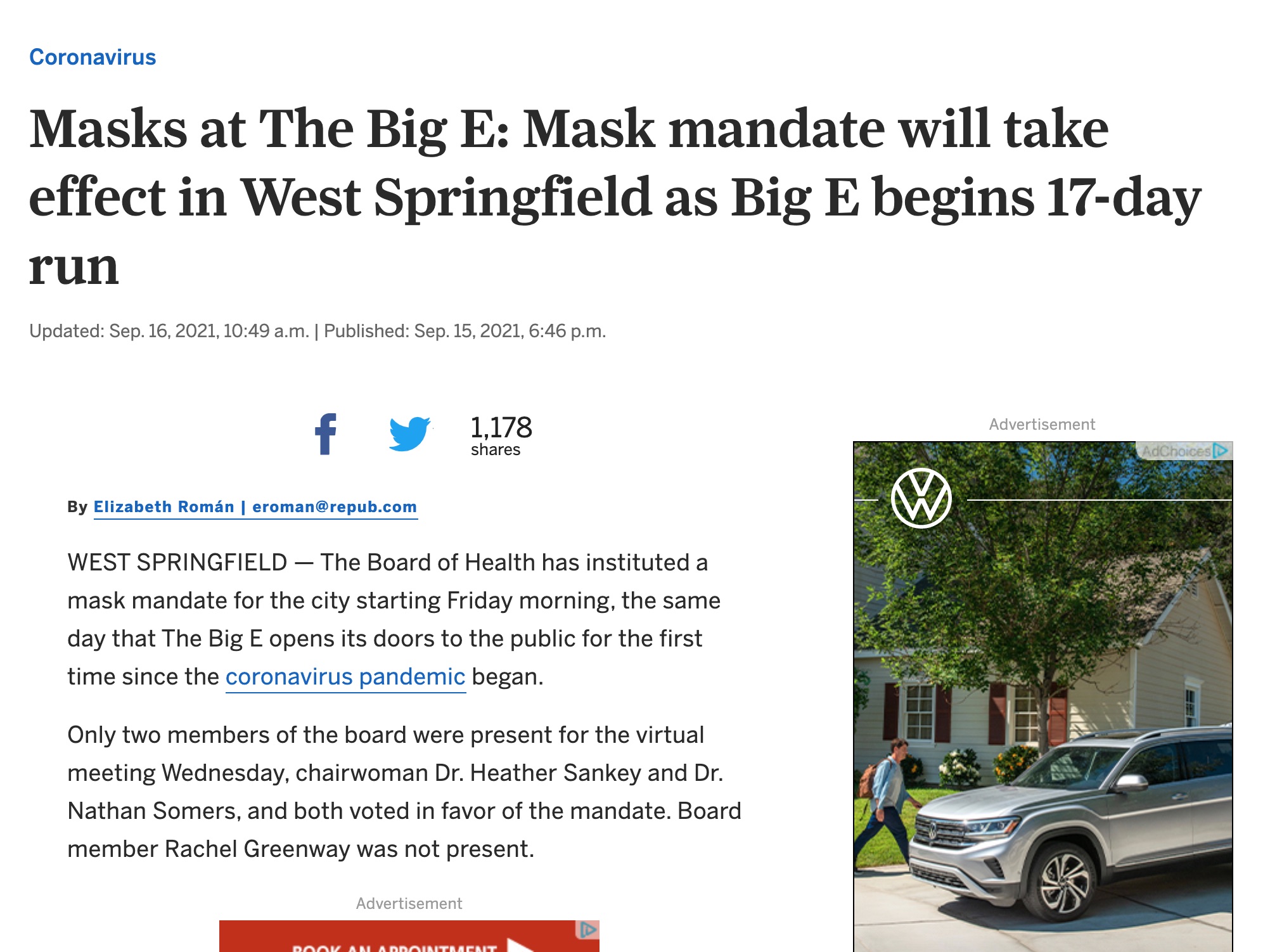 2021-09-16
2021-09-16"Masks at the Big E: Mask mandate will take effect in West Springfield as Big E begins 17-day run"
This MassLive article reports on the Board of Health's decision to enact an indoor mask mandate, which will affect the Eastern States Exposition, or Big E, held annually in West Springfield, MA. The New England fair was cancelled in 2020 and is trying to make a comeback in 2021 despite the pandemic. -
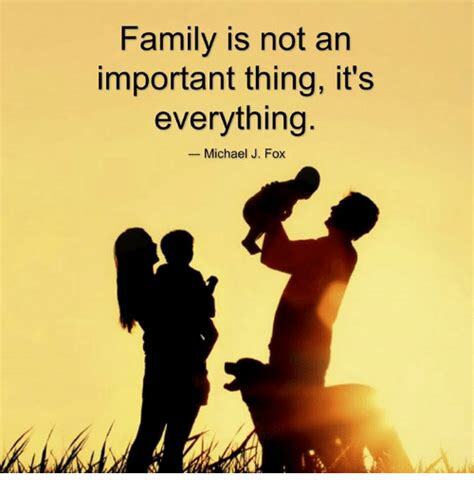 2021-09-16
2021-09-16How I Adapted
Starting a new chapter in your life can always be a little stressful simply because of the new change it brings. Coming from a farming county, I had just begun becoming comfortable moving into a big city during my freshman year of college. Second semester rolled around and out of nowhere COVID-19 immediately impacted my life. My once comfortable lifestyle I have adapted to in the big city changed back to my home where I started online classes. This was quite unusual because I had never taken any online classes and found myself struggling to learn from a screen rather than in-person classes. Weeks went by where I struggled to pay attention and succeed in the “classroom”. Although challenging, I adapted to something unfamiliar in my life and found my niche to succeed in a new environment once again. Adapting to something new can certainly be challenging for people. COVID taught people to adapt to something new in their lives. It brought people together in the community in ways that I had not thought possible. One example of this is when I found out my grandma of 88 years of age became ill with COVID. It was an unfortunate event for my family that took a toll on all of us when we first heard about the news. It became real. Real enough to worry, real enough to take action. Real enough to show the importance of family in times of pain and struggle. Our family had to adapt to my grandmother’s lifestyle for the next couple of months. This meant no big grandma hugs for 5 months until her body recovered from this foreign virus. This took some getting used to as I had not realized the real impact of COVID and perhaps did not see it as dangerous as I thought. Again, I adapted. I adapted to realize that the people around you can make situations like this less painstakingly hard. The comfort and prayers received from family and friends made it comforting to know people cared and were there for me and my family. COVID was something that impacted everyone in different ways. Just remember people listen and people are there. -
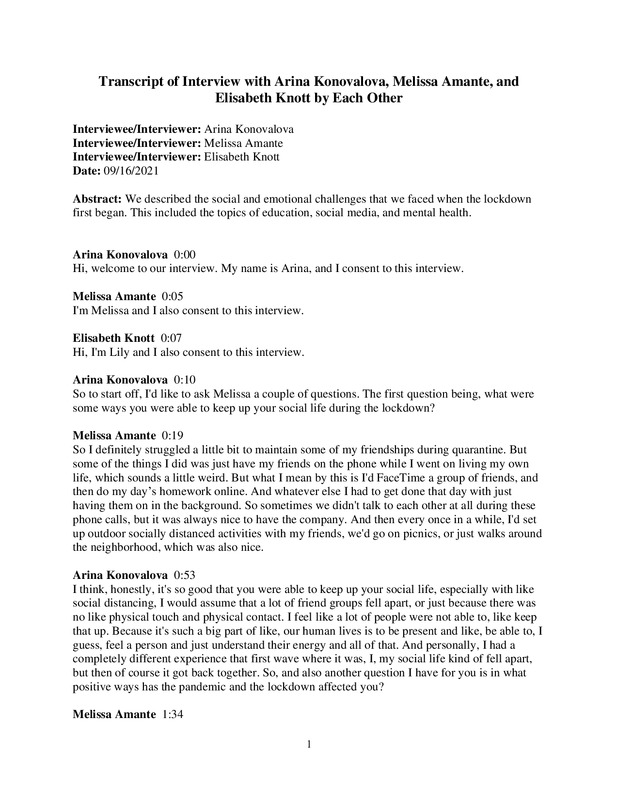 2021-09-16
2021-09-16Melissa Amante, Arina Konovalova, and Elisabeth Knott Oral History, 2021/09/16
We described the social and emotional challenges that we faced when the lockdown first began. This included the topics of education, social media, and mental health. -
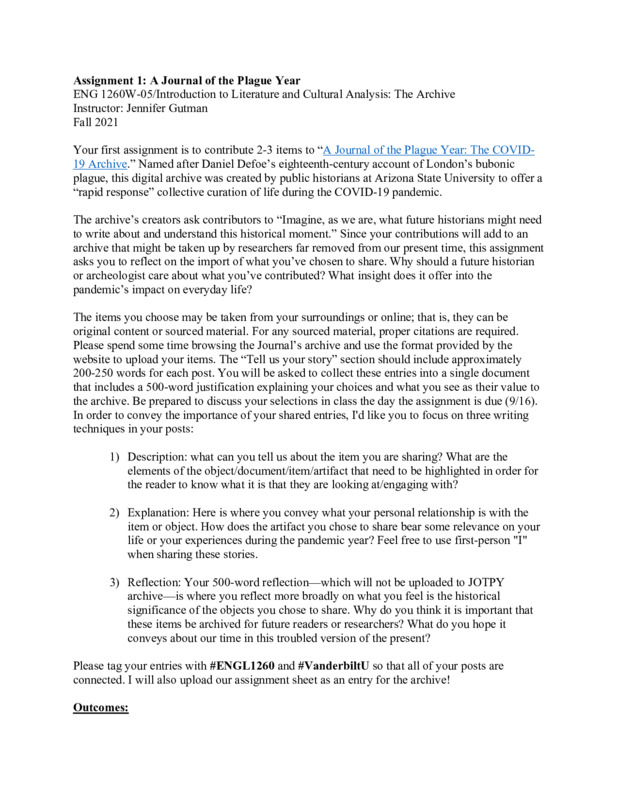 2021-09-16
2021-09-16Assignment for Literature and Cultural Analysis Seminar
I'm sharing an assignment sheet for my "Literature and Cultural Analysis" class at Vanderbilt University for the Fall 2021 semester. The class, themed "The Archive," is designed to encourage critical thinking around the concept of the archive and its material practices and embodiments. While we think of the ways in which archives enable research and help to cultivate new knowledge and stories, we also consider how archives encode structures of power and act as sites of forgetting as much as remembering. I've asked my class of twelve students to contribute to the COVID-19 digital archive as their first writing assignment for the semester. This assignment is designed to introduce them to an existing and regularly updated archive and ask them to think critically about processes of archiving and the decisions that go into selecting, categorizing, and framing the importance of a cultural artifact. My students have been asked to choose 2-3 items from their experience of the pandemic year to share in this public forum. Their contributions will be tagged to sync up with this assignment sheet.
